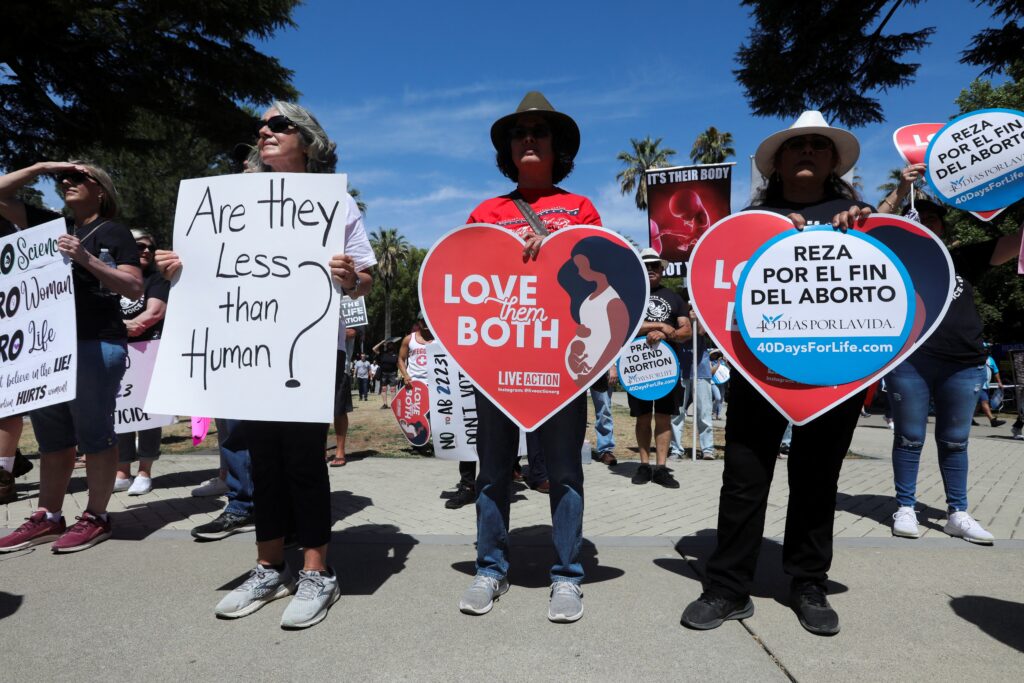
Clinics provided an estimated 179,700 abortions in California in 2023, a 16.6% increase in abortions since 2020
(OSV News) — In the aftermath of the U.S. Supreme Court’s Dobbs decision in 2022, California’s government set out to make the Golden State an abortion haven.
Two years later, after enshrining the right to abortion in the state’s constitution and spending millions to promote the life-ending procedure, California’s abortion numbers have grown.
According to the Guttmacher Institute, a research organization for the abortion industry, clinics provided an estimated 179,700 abortions in California in 2023, a 16.6% increase in abortions since 2020.
Although California’s abortion laws have been permissive for decades, the U.S. Supreme Court’s Dobbs v. Jackson Women’s Health Organization decision kicked off even more initiatives to promote and expand abortion, explained Molly Sheahan, associate director for healthy families at the California Catholic Conference, the lobbying arm of the California bishops. The Dobbs decision saw the Supreme Court overturn precedent that held abortion to be a constitutional right since the 1973 Roe v. Wade decision, and returned the issue of regulating or restricting abortion back to legislatures.
“We saw nearly 20 new bills expanding abortion in California and an investment of $200 million from the state budget focusing on improving privacy for those who perform or receive abortions, investments in abortion infrastructure, training for all kinds of health care professionals, (and) the creation of a new website … to promote the options for abortion and dissuade folks from seeking out pregnancy centers,” said Sheahan. “We saw the state remove any copay or deductible from abortion so it truly is free, and (launch) an investment in funds to pay for travel costs for those coming from out-of-state.”
Additionally, pro-abortion organizations such as ACCESS Reproductive Justice, a statewide abortion fund, make the procedure even more accessible. The organization states that in 2023 it assisted more than 1,500 individuals across California and the U.S. — a 150% increase since Dobbs — and thanks to state funding, spent over $788,400 on its health line, which was four times the amount in 2022.
Out-of-staters coming to California for an abortion account for some of the state’s increased abortion numbers. According to Guttmacher, around 6,500 abortions were performed on mothers coming from Arizona, Florida, Nevada, Louisiana, Tennessee and Texas, accounting for 3% of California abortions in 2023.
“Our governor (Gavin Newsom) has made us a sanctuary state,” said Marie Leatherby, executive director of the Sacramento Life Center in Sacramento, California. “He’s advertised across the country (with) TV ads (and) billboards that California is the place to come. And we’ll pay for everything — your travel, your stay, your abortion.”
But while there’s been a huge promotional push for abortion, parenting and adoption resources haven’t been promoted at all, say Catholic and pro-life advocates.
“There’s no pregnancy.ca.gov,” said Sheahan. Expectant families have to do their own legwork to tap into the state’s social services or to find support from a local pregnancy center, she explained, adding that waiting lists for affordable housing and childcare are very long. Pregnant mothers may have difficulty accessing health care as at least 46 California maternity wards have closed since 2012.
“If you’re searching for abortion, everything will be provided, but if you choose to parent you really are on your own,” Sheahan said. “What this amounts to is a systemic coercion of women.”
Not only does the state promote abortion, it makes the work of pregnancy centers more difficult, said Leatherby.
“The attorney general has been suing pregnancy centers; he’s investigating pregnancy centers; he’s subpoenaed pregnancy centers — they’re really out to shut us down,” she said. “Just let us do our work.”
Although many states have banned or tightened restrictions on abortions, abortions have increased nationwide since the fall of Roe. In 2023, there were more than 1 million abortions in the U.S., an 11% increase since 2020. According to Guttmacher, 2012 was the last year that abortions topped a million. The historic high for abortion was 1.6 million in 1990, and abortion saw a long-term decline, hitting a low of 885,000 in 2017 before starting to trend upward again.
Abortion was already on the rise in California before the Dobbs decision. According to Guttmacher, 132,680 abortions took place in California in 2017. Two years later, the number was 150,660.
Part of the rise could be attributed to the increase of medication or chemical abortions. The two-drug combination of mifepristone and misoprostol — which is also used today for early miscarriage care — accounted for 53% of all U.S. abortions in 2020 and 63% in 2023, according to Guttmacher.
During the pandemic, the U.S. Food and Drug Administration loosened an in-person dispensing requirement for the medication regimen and since then has removed it permanently.
Abortion by telehealth has also quickly grown. A Guttmacher policy analysis noted the number of U.S. providers offered telemedicine consultation “by video, phone call, text or online platform” and mailing abortion pills increased from 7% of those known to offer medication-based abortion in 2020 to 31% in 2022. It noted that online-only abortion clinics, which debuted in 2021, “accounted for 8% of all abortions provided within the formal health care system in the first six months of 2023.”
Despite the growing number of abortions, Sheahan doubts most women with an unexpected pregnancy truly desire abortion. She cited a study of 1,000 women aged 41-45 from the Charlotte Lozier Institute showing that 43% of women felt abortion was “inconsistent with their values and preferences” and another 24% felt the abortion was “unwanted or coerced.”
The study found 60% would have preferred to give birth rather than abortion if they had either more emotional support or more financial security. Only 33% said their abortions were wanted.
“We always hear that a lot of people have unwanted pregnancies — I think we have an unwanted abortion problem in the United States and it’s not something that’s being addressed,” she said.
Pregnancy center employees and volunteers see the problem firsthand. Almost all of the women who walk through the doors of the Sierra Pregnancy + Health medical clinic in Roseville, California, are afraid, said Mindy Hertzell, director of clinic operations.
“Fear is the motivator — whether it’s fear of lack of resources or shame, (or) fear that they won’t know what to do when they’re baby is born,” she told OSV News.
“We give them an alternative to the only choice they think they have,” Hertzell said.
Much like the more than 160 pregnancy centers in California, Sierra offers pregnancy tests, testing for sexually transmitted infections, ultrasounds, reversal procedures for medication-based abortions, parenting classes, diapers, baby clothes and more. In an average year they serve around 550 clients, said Hertzell.
In their work at the Sacramento Life Center, Leatherby and her staff meet women every day at risk for an unwanted abortion.
“We see a lot of low-income (families), a lot of immigrants, trafficked women — we see every kind of story,” she said. The changing pro-abortion landscape has made it more difficult for the licensed and nationally accredited medical clinic to reach women in need, so they work with a marketing company to get their message out. Last year, the center had nearly 2,500 patient visits.
“We spend more advertising money than ever before but our numbers still continue to increase,” she said.
Leatherby hopes the state government will start putting its resources toward serving expectant mothers in need, rather than encouraging them to abort. “(Women) feel desperate to end their baby’s life because they don’t feel supported,” she said. “Our state could at the least support both choices (rather) than leaving women with only one option.”
– – –
Zoey Maraist writes for OSV News from Virginia.


